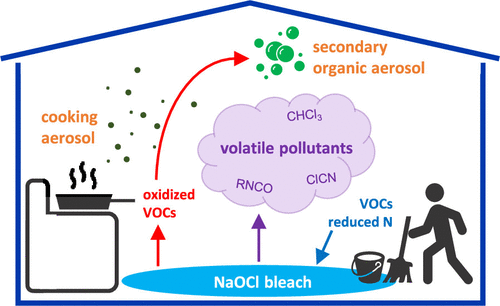当前位置:
X-MOL 学术
›
Environ. Sci. Technol. Lett.
›
论文详情
Our official English website, www.x-mol.net, welcomes your
feedback! (Note: you will need to create a separate account there.)
Dark Chemistry during Bleach Cleaning Enhances Oxidation of Organics and Secondary Organic Aerosol Production Indoors
Environmental Science & Technology Letters ( IF 8.9 ) Pub Date : 2020-09-09 , DOI: 10.1021/acs.estlett.0c00573 James M. Mattila 1 , Caleb Arata 2, 3 , Chen Wang 4 , Erin F. Katz 3, 5 , Andrew Abeleira 1 , Yong Zhou 6 , Shan Zhou 7 , Allen H. Goldstein 3, 8 , Jonathan P. D. Abbatt 4 , Peter F. DeCarlo 5, 9 , Delphine K. Farmer 1
Environmental Science & Technology Letters ( IF 8.9 ) Pub Date : 2020-09-09 , DOI: 10.1021/acs.estlett.0c00573 James M. Mattila 1 , Caleb Arata 2, 3 , Chen Wang 4 , Erin F. Katz 3, 5 , Andrew Abeleira 1 , Yong Zhou 6 , Shan Zhou 7 , Allen H. Goldstein 3, 8 , Jonathan P. D. Abbatt 4 , Peter F. DeCarlo 5, 9 , Delphine K. Farmer 1
Affiliation

|
Bleach can oxidize volatile organic compounds (VOCs) and contribute to secondary organic aerosol (SOA) indoors. During the House Observations of Microbial and Environmental Chemistry (HOMEChem) campaign, we observed indoor terpene mixing ratios decrease during bleach cleaning periods, with simultaneous increases in oxidized VOC (OVOC) products. Cooking just prior to bleach cleaning significantly increased SOA due to uptake of bleach-related OVOCs onto cooking aerosols. While SOA formation occurred, it was small (<3%) relative to total organic aerosol mass concentrations. Bleach cleaning chemistry also produced several potentially toxic chlorinated and nitrogenated VOCs indoors, including isocyanates, cyanogen chloride, and chlorocarbons. Observed volatile chlorinated organic acids were likely impurities from the bleach. The bleach-induced terpene oxidation, SOA formation, and chlorinated/nitrogenated VOC production were independent of indoor illumination, consistent with dark chemical production. These observations add to previous studies that demonstrate bleach as a source of potentially harmful primary and secondary pollutants to indoor air.
中文翻译:

漂白清洁过程中的深色化学物质可增强室内有机物和次级有机气溶胶的氧化
漂白剂可氧化挥发性有机化合物(VOC),并有助于室内的二次有机气溶胶(SOA)。在众议院微生物与环境化学观察(HOMEChem)活动中,我们观察到室内萜烯的混合比在漂白剂清洁期间会降低,同时氧化的VOC(OVOC)产品也会增加。由于将与漂白剂相关的OVOC吸收到烹饪气溶胶中,因此在清洁漂白剂之前进行烹饪会显着提高SOA。当发生SOA形成时,相对于总有机气溶胶质量浓度而言,它很小(<3%)。漂白剂清洁化学剂还会在室内产生几种潜在有毒的氯化和氮化的VOC,包括异氰酸酯,氯化氰和氯碳。观察到的挥发性氯化有机酸可能是漂白剂中的杂质。漂白剂诱导的萜烯氧化,SOA的形成以及氯化/氮化的VOC的产生与室内照明无关,这与深色化学物质的产生一致。这些发现增加了以前的研究,这些研究表明漂白粉是室内空气中潜在有害的主要和次要污染物的来源。
更新日期:2020-11-12
中文翻译:

漂白清洁过程中的深色化学物质可增强室内有机物和次级有机气溶胶的氧化
漂白剂可氧化挥发性有机化合物(VOC),并有助于室内的二次有机气溶胶(SOA)。在众议院微生物与环境化学观察(HOMEChem)活动中,我们观察到室内萜烯的混合比在漂白剂清洁期间会降低,同时氧化的VOC(OVOC)产品也会增加。由于将与漂白剂相关的OVOC吸收到烹饪气溶胶中,因此在清洁漂白剂之前进行烹饪会显着提高SOA。当发生SOA形成时,相对于总有机气溶胶质量浓度而言,它很小(<3%)。漂白剂清洁化学剂还会在室内产生几种潜在有毒的氯化和氮化的VOC,包括异氰酸酯,氯化氰和氯碳。观察到的挥发性氯化有机酸可能是漂白剂中的杂质。漂白剂诱导的萜烯氧化,SOA的形成以及氯化/氮化的VOC的产生与室内照明无关,这与深色化学物质的产生一致。这些发现增加了以前的研究,这些研究表明漂白粉是室内空气中潜在有害的主要和次要污染物的来源。











































 京公网安备 11010802027423号
京公网安备 11010802027423号